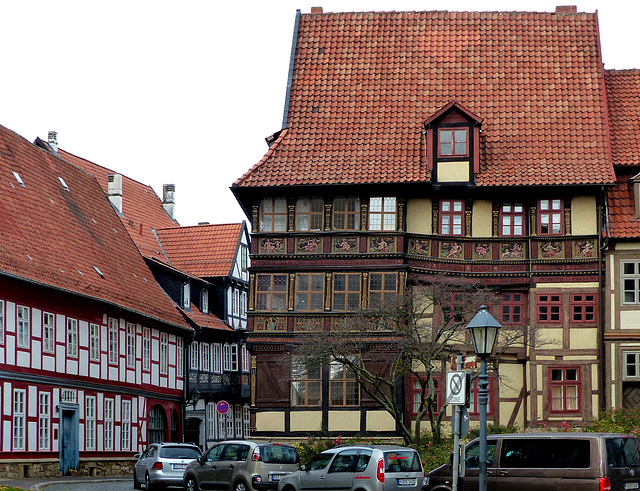Hildesheim - Wernersches Haus
Quakenbrück - St. Marien
Frankfurt - Haus zur Goldenen Waage
Braunschweig
Braunschweig
Güsen - Dorfkirche
Güsen - Dorfkirche
Tangermünde - Kirchstrasse
Tangermünde - Kirchstrasse
Quedlinburg
Göttingen - Junkerschänke
Korbach - Rathaus
Korbach
Shrewsbury
Shrewsbury
Hildesheim - Waffenschmiedehaus
Hildesheim
Hildesheim - Wedekindhaus
Hildesheim - Knochenhaueramtshaus
Hildesheim - Knochenhaueramtshaus
Schwalenberg - Künstlerklause
Schwalenberg - Malkasten
Schwalenberg
Schwalenberg - Rathaus
Schwalenberg - Rathaus
Belle - Kapelle
Hannover - Burgstrasse
Ogbourne thatch
timer frame and thatch
Bad Meinberg
Horn - Nordstrasse
Frankenberg - Rathaus
Frankenberg - Rathaus
Olde English Chinese Medicine?
Horseshoe House
Tudor House, Sutton Courtenay
Tudor brick nog
Staple Inn, Holborn
Lloyds Bank bus stop
The Sun Inn at Coate
Lloyds Bank bus stop
Court House, Pewsey
half timbered at Upavon
Marlborough thatch
Plymouth Merchant's House
The Green, Marlborough
old house in Silverless Street
Location
See also...
Keywords
Authorizations, license
-
Visible by: Everyone -
All rights reserved
-
25 visits
Hildesheim - Wernersches Haus


Louis the Pious founded the bishopric of Hildesheim in 815. The settlement developed into a town and was granted market rights by King Otto III in 983. Craftsmen and merchants were attracted and the city developed into an important community. By 1167, Hildesheim was an almost completely walled market settlement.
At the beginning of the 13th century, Hildesheim had about 5,000 inhabitants, and when Hildesheim received its city charter in 1249, it was one of the largest cities in northern Germany. The clergy ruled Hildesheim for four centuries before a town hall was built and the citizens gained influence and independence. In 1367, Hildesheim became a member of the Hanseatic League. But what is now called Hildesheim was various small "suburbs". After centuries of (sometimes armed) disputes, it was not until the end of the 16th century that a union was created and subsequently at least the inner wall was taken down Old and New Town.
During the Thirty Years' War, Hildesheim was besieged and occupied several times. In 1813, after the Napoleonic Wars, the town became part of the Kingdom of Hanover, which was annexed by the Kingdom of Prussia as a province after the Austro-Prussian War in 1866.
The air raids on Hildesheim in 1944/45 destroyed large parts of the city. Of the 1500 half-timbered houses, only 200 remained. 90 percent of the historic old town was destroyed in the firestorm.
-
A small area in the southern part of the old town, the area around the Godehardikirche, remained largely intact during the war. The stately Werner House is a Renaissance half-timbered house dates back to 1606 and is named after its builder, the episcopal secretary Philip Werner. It suffered fire damage during the bombing of Hildesheim in 1945, which had already been repaired by 1948.
At the beginning of the 13th century, Hildesheim had about 5,000 inhabitants, and when Hildesheim received its city charter in 1249, it was one of the largest cities in northern Germany. The clergy ruled Hildesheim for four centuries before a town hall was built and the citizens gained influence and independence. In 1367, Hildesheim became a member of the Hanseatic League. But what is now called Hildesheim was various small "suburbs". After centuries of (sometimes armed) disputes, it was not until the end of the 16th century that a union was created and subsequently at least the inner wall was taken down Old and New Town.
During the Thirty Years' War, Hildesheim was besieged and occupied several times. In 1813, after the Napoleonic Wars, the town became part of the Kingdom of Hanover, which was annexed by the Kingdom of Prussia as a province after the Austro-Prussian War in 1866.
The air raids on Hildesheim in 1944/45 destroyed large parts of the city. Of the 1500 half-timbered houses, only 200 remained. 90 percent of the historic old town was destroyed in the firestorm.
-
A small area in the southern part of the old town, the area around the Godehardikirche, remained largely intact during the war. The stately Werner House is a Renaissance half-timbered house dates back to 1606 and is named after its builder, the episcopal secretary Philip Werner. It suffered fire damage during the bombing of Hildesheim in 1945, which had already been repaired by 1948.
kiiti, uwschu, Marco F. Delminho have particularly liked this photo
- Keyboard shortcuts:
Jump to top
RSS feed- Latest comments - Subscribe to the comment feeds of this photo
- ipernity © 2007-2024
- Help & Contact
|
Club news
|
About ipernity
|
History |
ipernity Club & Prices |
Guide of good conduct
Donate | Group guidelines | Privacy policy | Terms of use | Statutes | In memoria -
Facebook
Twitter

Sign-in to write a comment.